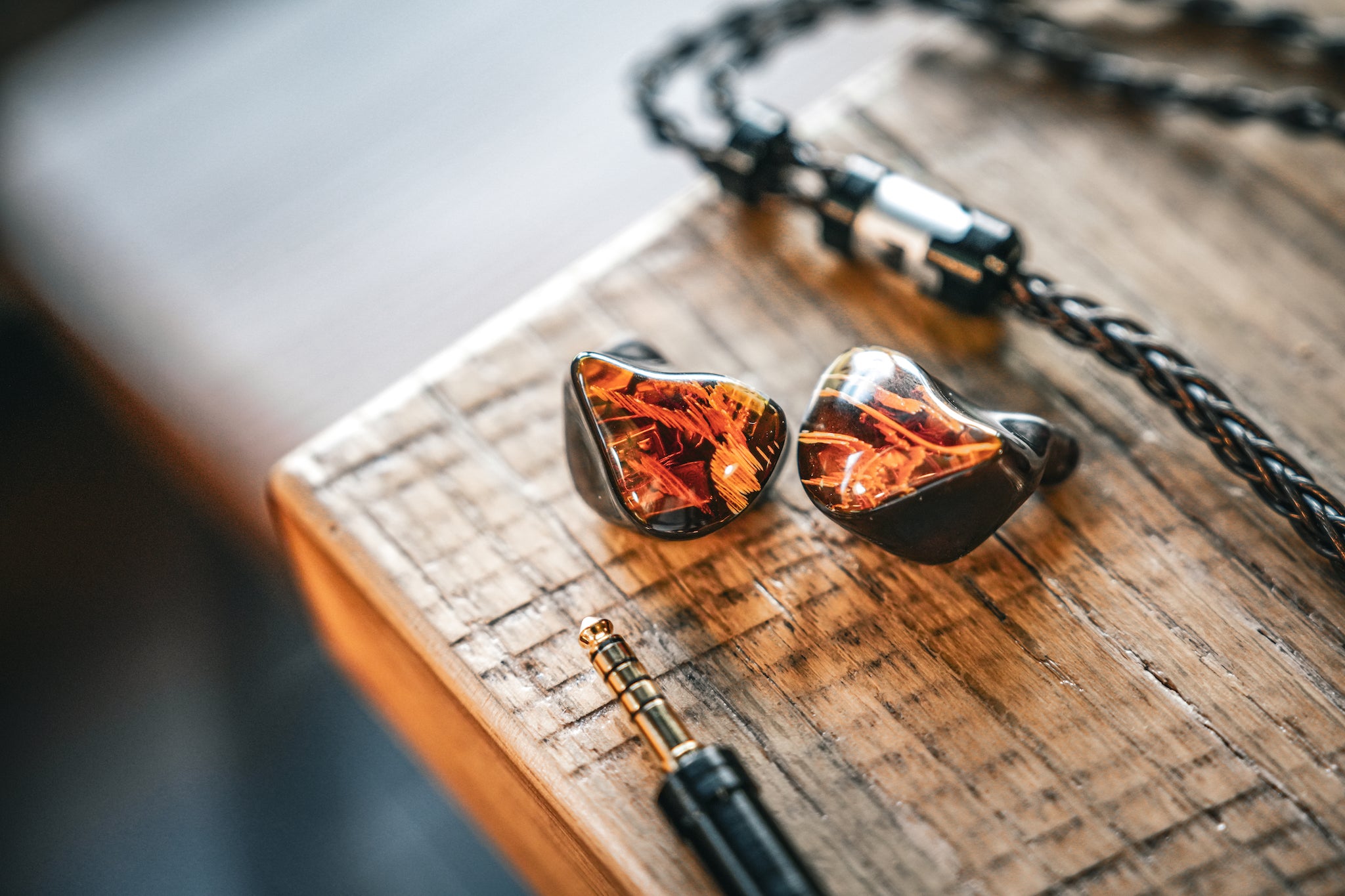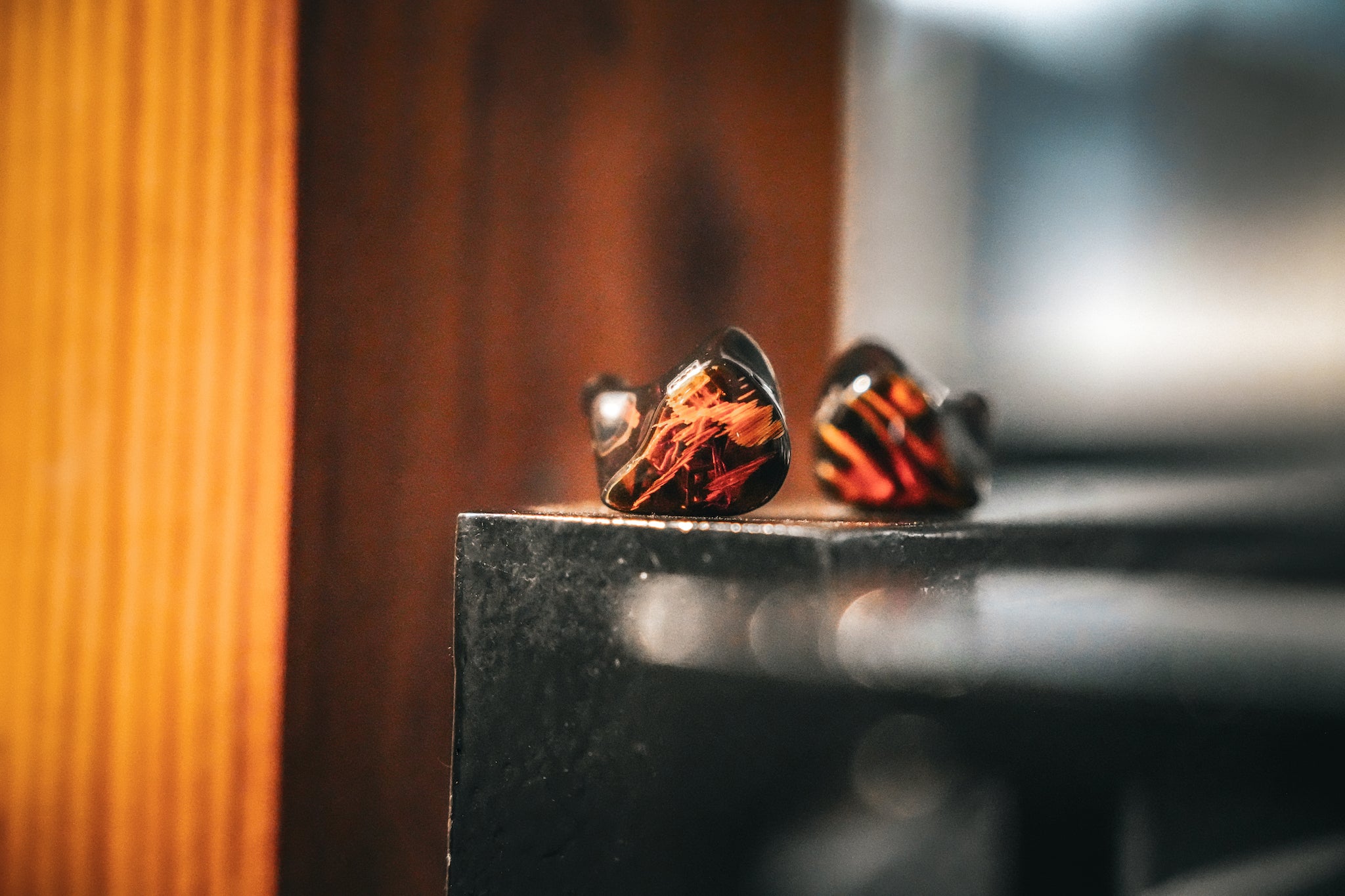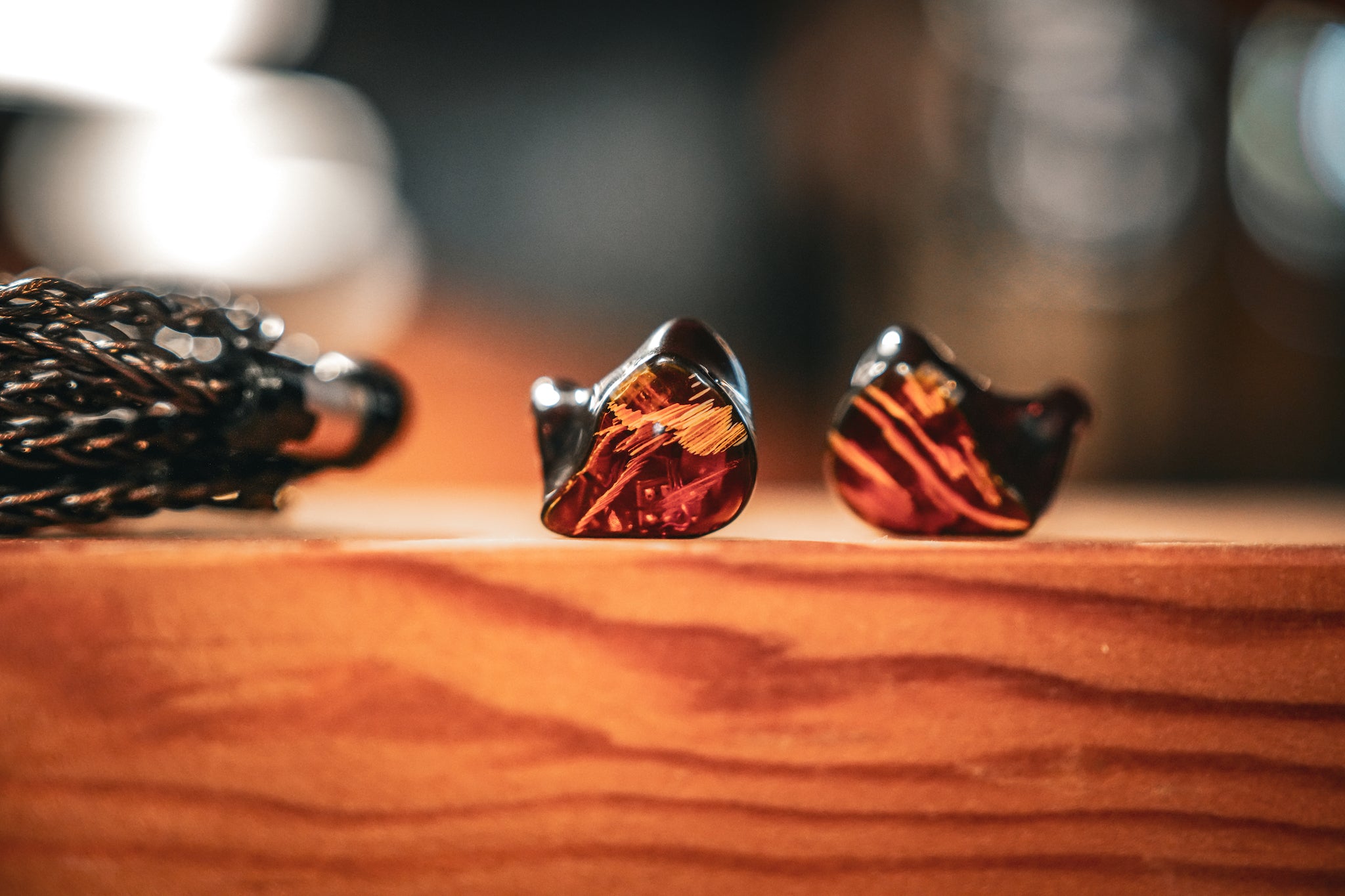Noble Audio has drawn upon rulers and kings from cultures around the world with IEM names like Viking Ragnar, Khan, or Sultan, and while he was never a king, Spartacus may have been the most noble of them all. Spartacus is one of the great heroes of history: a slave, a gladiator, and the leader of a rebellion that sought to provide equality for all within the Roman Empire. At a $1799 price point, I’m not expecting Noble Spartacus to be the headphone equivalent of the historical hero, but does it stand tall among the many great IEMs on the market right now?
Build and Design
Spartacus is a traditional resin style IEM with a slight twist: the translucent faceplate uses an organic fiber material which gives each unit a one-of-a-kind finish. The shell itself is smaller than most IEMs in this range, and seems to be an easy, comfortable fit for most. Inside Spartacus uses four balanced armature drivers and two bone conduction drivers per side to create its signature sound.
The package includes the standard Noble Audio items, like a selection of tips and a Pelican case, as well as the new Noble cable. The cable has a similar feel to their classic 8-core copper cable, but with the added convenience of a modular tip system. 2.5mm, 3.5mm, and 4.4mm options are all included.
Sound
The more I listened to Spartacus, the more its name made sense. Spartacus is the IEM of a warrior: fast, powerful, and physical, but also nimble and precise. Spartacus delivers thunderous lows and thick bass slam, but also has the speed and resolution to render details and texture in the music. Spartacus seems tailored for fans of fast, technical music. Whether it’s “In the Hall of the Mountain King” or “Dance of Eternity,” the precision, resolution, and power of Spartacus provides an experience that’s both highly detailed and highly engaging.
I was initially skeptical of the combination of bone conduction and balanced armatures that Spartacus uses for the bass, but the combo offers a “best of both worlds” bass experience that is also surprisingly cohesive. The bone conduction provides seemingly bottomless bass extension and physicality, while the BAs and speed and detail to the equation. The end result is fast, clean, powerful, and deep in equal measures.
Spartacus is somewhat v-shaped, pulling the mids back slightly, but without losing too much in terms of accuracy and clarity. The bass makes a nice clean transition up, but you do lose something in the low mids through the process. Vocals are presented more forward, and a little bit intimate, but Spartacus avoids triggering potential vocal hotspots or sibilance.
The treble is balanced, with good extension, but also a slightly smooth character. Transients feel clear on the attack, and quickly smooth out as they decay. This treble delivery gives cymbals a crisp clear character, and enhances the dynamics of fast playing with a heightened sense of urgency.
Spartacus presents a wide three-dimensional soundstage with a strong, focused center image. Spartacus tends to arrange instruments a bit wider and deeper in the image, with a slightly diffuse feeling, while bringing vocals or lead instruments more forward and center. There’s almost a sense of a spotlight on whatever the mix is highlighting – whether its vocals, a guitar solo, or an instrument taking the melodic lead in a film score.
Tosin Abasi, of Animals as Leaders fame, is renowned among guitarists for crafting a unique tone and delivering performances that are equal parts punishingly heavy and stunningly articulate. “Monomyth” is a great example of this. The 8-string guitar produces tones so heavy they have their own gravitational pull, but listening with Spartacus reveals each thread of fuzz on the perfectly crafted guitar tone, while hitting you with the full weight of the crushingly powerful guitar playing. And when the bass hits – somehow even deeper – there’s a thick, rumbling in the low-end, punctuated by Spartacus’s fast, physical delivery of the drums.
Spartacus hits you with front and center vocals on “Where Are You Going” by Dave Matthews, with the bass drum lending its impact just underneath the vocals. There’s a great deal of clarity in each instrument, though the timbre on the guitar and violin isn’t fully natural. The presentation feels a bit like front row seats at a stadium: you get the up close, front and center vocals, coupled with a wide and deep soundstage that places the band around the stage. The dense instrumentation is something Spartacus handles perfectly, letting you pull back the layers on the sometimes cacophonous arrangement created by the band’s more freeform composition style.
The arpeggiated synth that serves as the foundation of DeadMau5’s “4ware” also gives you a clear outline of Spartacus’s soundstage width as it sweeps from left to right. When the bass hits, it comes down the middle with a round, physical thump. Spartacus captures the subtle dynamics and texture of the bass quite well, as each note has a fast slide into the note that’s lost on lesser headphones rather than attacking directly on the note. The top end is clear, but just slightly smooth, taking the sharpness off the highest notes while presenting a balance that favors the deep droning of the bass without missing any of the other details.
“Now We Are Free” from the Gladiator soundtrack delivers a hard to define sense of forward movement and open space. Spartacus leans into this, putting the vocals up close to the listener, while spreading the instruments out across the open space. The bedrock formed by the percussion is deep and detailed, while the string ensemble feels almost like it’s spread across the sky.
Comparison: 64 Audio Volur ($2499), Fir Audio Neon4 ($2299)
Deep, fast, textured bass, coupled with strong overall tonal balance sound familiar? It seems like just yesterday that we were saying similar things about the 64 Audio Volur. While Volur hits a slightly higher price point, the two still have some interesting elements to compare. And while we already covered it in our Volur review, FiR Audio Neon4 is another interesting comparison here as it tries to accomplish something similar with its BA + DD “Kinetic Bass” as compared to Spartacus’s BA + Bone Conduction bass.
Each of these IEMs do something interesting with their bass. Ne4 starts with a “classic basshead” sound, adds a low BA driver to provide clearer articulation, and rounds it out with the added physical force of the Kinetic Bass venting. Volur is almost “post-basshead” with some of the best bass quality on the block, but without as strong an emphasis. Spartacus is more experimental, with a bass quantity closer to Ne4, combined with a unique quality and texture.
For pure speed and detail in the bass, Spartacus is the winner, but Volur isn’t far off, delivering a more natural bass than Spartacus’s vivid supernatural low end. Ne4’s penchant for impact and rumble exceed even Spartacus’s dynamic driver, but there’s a slight sense of bloat in the midbass which neither of the others experience.
Ne4 provides a warm transition into the low mids that’s sure to appeal to fans of rock and hip hop, but Volur’s detail, timbre, and vocal presentation is a step up from the others, capturing the midrange crown. Spartacus has a timbre that’s hard to quantify. It’s neither warm nor bright, but also not quite natural. There’s roundness to notes that rules out “tinny,” and leaves me feeling like it’s the sonic equivalent of a “cool” color temperature.
Spartacus’s “cool” feeling extends to the treble, with great clarity and resolution, but also a liquidy smoothness. Volur opts for an airier, more extended treble, giving an exquisite reproduction of the upper frequencies that will make treble lovers rejoice, but might feel more like penance for the treble sensitive. Ne4 has the fundamentals, but might feel slightly veiled to some.
In the imaging, all three are wide and provide good three-dimensionality, but Volur delivers the clearest most holographic presentation. Spartacus is a close match with Volur in overall soundstage size, but doesn’t quite bring the size, positioning, and cohesion together in the same way. Ne4 has the sort of well-blended, cohesive imaging that gives listeners a feeling that’s more “on stage” than the more studio-like presentation of the other two IEMs.
Considering that Spartacus is up against competition at $500 and $700 above its price point, it ends up looking really good. While it doesn’t have the same sort of balance that Volur provides – or the classic warmth of Ne4 – it’s overall balance and insanely fast, technical bass, make it a strong contender.
The Bottom Line
In spite of all the IEMs that come out in a given year, only a handful really feel like they’re pushing the industry forward with new ideas and innovation. Spartacus is one of those IEMs. It’s not a perfect all-arounder, but Spartacus feels like a game changer for music produced in the last 20 years. Whether it’s electronic music, highly technical rock and metal, or even recent film scores that blend classical instrumentation with elements of rock and electronic music, Spartacus captures elements of modern music recording with the sort of focus that I haven’t heard before in an IEM.









